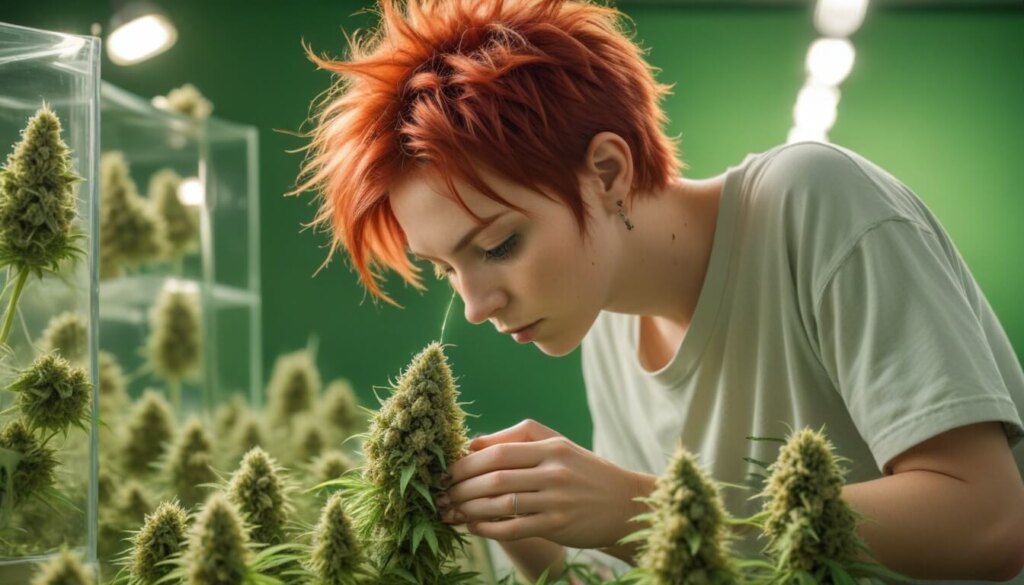Cannabis trichomes, or the shiny glandular layer that appears on various parts of the cannabis plant serve several important functions. Apart from protecting the plant and keeping it safe from external insults, these trichomes also help preserve the potency of cannabinoids. What do trichomes look like when they are ready and how to judge if the trichomes are ripe enough to be harvested and used for their relevant benefits? Let’s dive in!
The Trichome Timeline: From Clear to Cloudy to Amber
Cannabis trichomes pass through different stages of development to reach their final stage of harvesting. What are cannabis trichomes and how their color helps decide the cultivators and harvesters regarding when the crops are fully ready to be harvested?
Clear Trichomes
The primary stage in the development of the trichomes is quite distinctive, being rendered transparent and clear. At this time, the trichomes are functioning in the production of the cannabinoids and terpenoids but they are still not at the peak of their production.
The clearer trichomes reveal that the THC level is still not developed yet, and the harvesting at this stage will yield seedlings/heads containing a lower THC level with a more subtle flavor.
Cloudy Trichomes
When buds start to become cloudy or milky, it means that they are ready to crop. The trichomes transform from clear white to finger-like-cloudy, which is the indication of the attainment of the maximum THC level, with even more robust potency and flavors.
Amber Trichomes
Come to the final trichome lifecycle stage, the fabric will go from frosty to amber or golden color. This phenomenon occurs because THC starts transforming into CBN, a cannabinoid, endowed with strong drowsy properties, and many more CBN benefits.
Amber trichomes can be considered the ultimate cure for stressful days when you are looking for genuine relaxation by Indica strains or couch-lock effect fans.
Tools of the Trade: Examining Trichomes Up Close
Proper analysis of trichomes is the key for growers to examine the most suitable time for harvest as well as to produce genuinely top-quality cannabis.
Step 1: Naked Eye Inspection
Begin by optically inspecting your cannabis buds at a basic level. The possibility of spotting a gleaming and icey conglomerate of trichomes is a clear indication of the presence of enough frost.
This shimmering resembles a dust that is enchanting and magical, therefore it is a clear indication that there is a proper formation of trichomes.
Step 2: The Jeweler’s Loupe
The Jeweler’s Loupe is an amazing binocular that will get you to the grassroots of your THC. Offering 10x to 30x magnification, this multi-purpose instrument, which is either online or in hardware shops, is one example of a magnifying tool that is available nowadays.
Step 3: Regular Inspection
For the growers, regular check-ups for the trichomes as harvest day draws closer are a must thing. You had better start checking your trichomes weekly and if you continue to notice rapid changes you want to increase that to every other day or so.
Perform these check examinations so that you can follow through trichome maturity and eventually pull the plants at the right time when the cannabinoid and terpene profiles are satisfactory to you.
Reading the Trichomes: A Visual Guide to Harvest Readiness
Below is a guide on how to deal with complex trichome changes for you to have an optimum harvesting time without any problem.
Clear Trichomes (Early Stage)
- Appearance: In this phase, the trichomes represent transparent glass.
- Effects: These trichomes still do not have full THC potential, and this affects the way users experience cannabis. Therefore, most of the results right now are usually yielding “speedy” or “psychedelic” effects that may not be liked by those who want the relaxing or euphoric feeling most users usually get with fully matured cannabis.
White/Milky Trichomes (Peak Potency)
- Appearance: Milky trichomes, a whitish smudge, points to the transformation process.
- Effects: This stage is typically considered where THC and CBD potency reaches its highest levels. The effects are very intense and multi-dimensional, reaching both the mind and the body pretty well.
Amber/Yellow/Golden Trichomes (Late Stage)
- Appearance: Trichomes start to get a yellowish, brownish, or amber hue as they mature.
- Effects: Then THC goes through the conversion process into CBN which is a less active cannabinoid and is known for its sedating properties. It results in the so-called “couch lock” when the stimulation is not as significant as in cases of more cerebral activity.
Analyzing the Role of Exotic Trichomes in the Color Palette
Such individual strains may have purple, pink, or other particularly unusual colors, and trichomes that are genetically unique or narrowly bred for desired qualities. Such a peculiarity of trichomes is not usually accompanied by a standard transition from clear to amber.

Common Trichome Myths and Mistakes to Avoid
Let’s shed light on a few of these myths but also give a direction on best practices that will ensure you are getting the best out of your cannabis quality and potency.
Misconception 1: Stressing Plants Improves Potency
Truth: We should take into account that only specific types of stress may cause the level of endocannabinoids to increase such as light stress or fluctuations with temperature, and otherwise saying that we add more THC to buds by shaking them frequently is a myth.
Misconception 2: Gloves Mean You Can Handle Buds Freely
Truth: Without a doubt, gloves have the major purpose of guarding both trichomes and human fingers from oils and germs. It is even a must to minimize contact, avoid touching with our bare hands, and handle buds carefully. So, every contact you can have will potentially damage trichomes. So, you should limit the direct contact to be on the side, even with the protection.
Misconception 3: More Trichomes Mean Higher THC Levels
Truth: While the quantity of the trichomes can be related to the potency sometimes the quality and maturity of the trichomes are equally important for the production of the edible plants. Clear trichomes, for example, if not fully ripe are still incapable of yielding the required high-potency THC level. Conversely, milky white or amber trichomes suggest that the plant is almost at the point of mature cannabinoids.
Tailoring the Harvest to Your Preferences
Achieving a cannabis harvest that matches your exact preferences requires a deep understanding of plant development, especially the role of trichomes in signaling optimal harvest timing. By carefully monitoring the color change of the trichomes, from clear to milky white to amber, producers can achieve the desired efficacy, whether it be a vibrant cerebral high, a balanced euphoria, or a deeply calm mood. and can effectively decide when to harvest to achieve the effect.
Strategic cultivation techniques such as adjusting light exposure, managing nutrients, and controlling stress can further refine the results and improve the quality and specific properties of the final product. Remember that successful cultivation is as much about the science of understanding plant physiology as it is the art of adapting to the nuances of each variety and growing environment.
Customizing your harvest based on these principles not only maximizes the potency of your cannabis but also makes the growing process a more personal and rewarding experience. Whether you’re an experienced grower or a beginner, by taking the time to understand and apply these insights, you can achieve superior results that perfectly fit your cannabis consumption goals.





